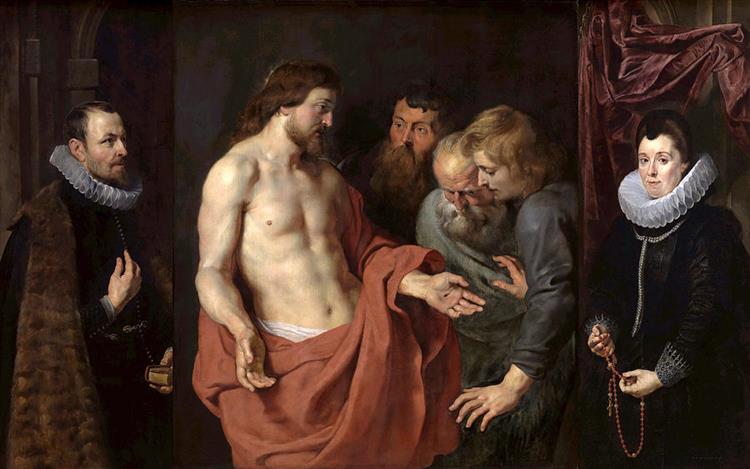Beskrivelse
Peter Paul Rubens's The Incredulity of Saint Thomas is an outstanding example of Baroque art, a period characterized by its dramatic depiction of emotions and use of dynamic aesthetics. Painted in 1613-1615, this work captures a pivotal moment in Christian narrative: the moment when Saint Thomas, one of Jesus' apostles, touches the wound in the side of the resurrected Christ, a scene that symbolizes human faith and doubt.
Rubens, known for his mastery of composition and color, employs a remarkable use of light and shadow to emphasize the interaction between the characters. The shovel is framed on a diagonal that guides the viewer's gaze toward the center of the action. In the painting, the contrasting chiaroscuro highlights the figure of Christ and the expression of astonishment and disbelief of Saint Thomas, who is in a semi-bowed position, approaching the divine figure, suggesting both his doubt and his eventual acceptance of faith.
The colours in this painting are rich and vibrant, a hallmark of Rubens' work. The warm tones of the background, ranging from browns and golds to darker, deeper hues, contrast with the paleness of Christ's skin and the liveliness of the other characters' clothing. This colour choice not only serves to enhance the figures, but also lends a sense of depth and three-dimensionality to the scene.
The characters in the work are equally significant. St. Thomas, portrayed with an expression of wonder and doubt, not only represents the skeptic, but also humbles himself before the divinity, prompting a reflection on the relationship between humanity and faith. The other apostles, present in the scene, watch with looks of fascination and wonder, leading the viewer to feel the tension of the moment. These elements not only enrich the visual narrative, but also hint at a dialogue between the divine and the human.
Rubens, being one of the greatest painters of his time, is also noted for his ability to capture emotion and theatricality. The proximity of the figures and the tension implicit in St. Thomas' gesture to touch Christ's wound are complemented by the intense expressiveness he manages to capture in their faces and postures. This work embodies the Baroque ideal of dynamism and movement, where the figures seem to almost emerge from the surface of the canvas, engaging the viewer in its visual narrative.
In the context of its output, The Incredulity of St. Thomas ranks among Rubens' masterpieces that explore themes of religion and humanity. This kind of emotional and symbolic representation can be seen in other pieces from the Baroque period, where artists such as Caravaggio and Rembrandt also addressed themes of faith and doubt, albeit each from their own unique perspective. However, Rubens' approach, with its vibrant palette and dramatic gestures, offers a distinctive blend of sensuality and spirituality that is hard to match.
Thus, "The Incredulity of Saint Thomas" not only illustrates a decisive moment in Christian history, but also encapsulates the complexity of human faith and the fears that come with it, all while evidencing the technical and expressive virtuosity of Rubens, an artist who continues to resonate deeply in the contemporary art world.
KUADROS ©, a famous painting on your wall.
Hand-made oil painting reproductions, with the quality of professional artists and the distinctive seal of KUADROS ©.
Painting reproduction service with satisfaction guarantee. If you are not completely satisfied with the replica of your painting, we will refund 100% of your money.

